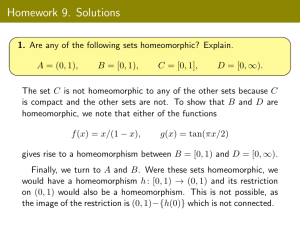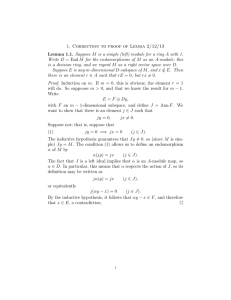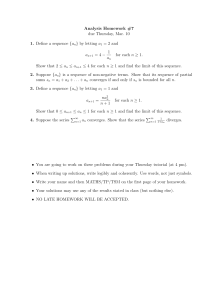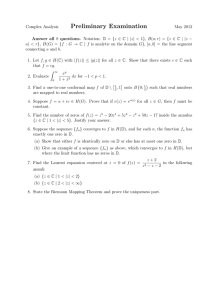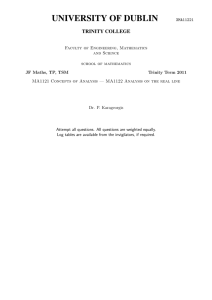Homework 5 Math 501 Due October 3, 2014 Exercise 1
advertisement
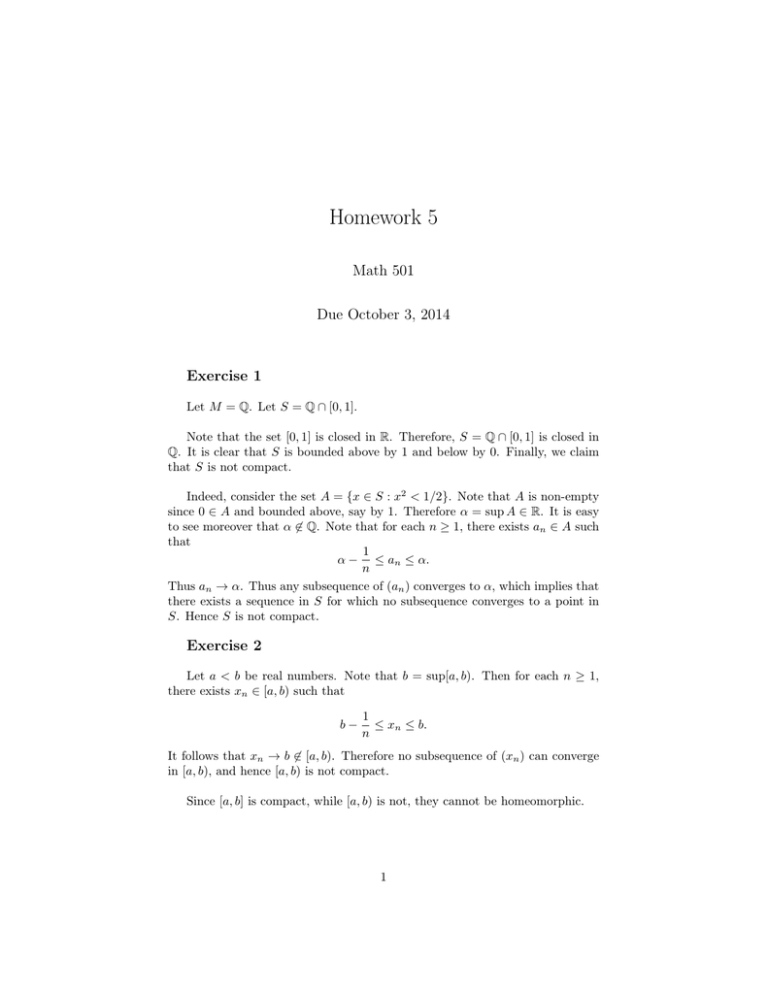
Homework 5
Math 501
Due October 3, 2014
Exercise 1
Let M = Q. Let S = Q ∩ [0, 1].
Note that the set [0, 1] is closed in R. Therefore, S = Q ∩ [0, 1] is closed in
Q. It is clear that S is bounded above by 1 and below by 0. Finally, we claim
that S is not compact.
Indeed, consider the set A = {x ∈ S : x2 < 1/2}. Note that A is non-empty
since 0 ∈ A and bounded above, say by 1. Therefore α = sup A ∈ R. It is easy
to see moreover that α 6∈ Q. Note that for each n ≥ 1, there exists an ∈ A such
that
1
α − ≤ an ≤ α.
n
Thus an → α. Thus any subsequence of (an ) converges to α, which implies that
there exists a sequence in S for which no subsequence converges to a point in
S. Hence S is not compact.
Exercise 2
Let a < b be real numbers. Note that b = sup[a, b). Then for each n ≥ 1,
there exists xn ∈ [a, b) such that
b−
1
≤ xn ≤ b.
n
It follows that xn → b 6∈ [a, b). Therefore no subsequence of (xn ) can converge
in [a, b), and hence [a, b) is not compact.
Since [a, b] is compact, while [a, b) is not, they cannot be homeomorphic.
1
Exercise 3
Define for each n ≥ 1 the sequence
en = (0, . . . , 0, 1, 0, . . .)
which has 1 in coordinate n and 0 in all other coordinates.
We first prove the following lemma.
Lemma 1. A convergent sequence in a metric space is Cauchy.
Proof. Suppose that pn → p. Let > 0. Then there exists N ∈ N such that
d(pn , p) < /2
for all n ≥ N . Observe that for every n, m ≥ N
d(pn , pm ) ≤ d(pn , p) + d(p, pm ) < ,
which implies (pn ) is Cauchy.
Let (enk ) be any subsequence of (en ). To see that (enk ) does not converge,
it suffices by the above lemma to show that it is not Cauchy. Indeed, observe
that for all k 6= k 0 ≥ 1
d(enk , enk0 ) = 1.
It follows that (enk ) is not Cauchy.
Exercise 4
Let f : M → N be a homeomorphism and let A ⊂ M .
Lemma 2. Let f : M → N be a homeomorphism. Let U ⊂ M be open, and let
C ⊂ M be closed. Then f (U ) ⊂ N is open and f (C) ⊂ N is closed.
Proof. Let g : N → M denote the inverse of f . Note that g is continuous.
Therefore, g −1 (U ) is open. Moreover, f (U ) = g −1 (U ). The argument for C is
similar.
Lemma 3. Let f : M → N be a map and suppose A ⊂ B ⊂ M . Then
f (A) ⊂ f (B).
Proof. Let y ∈ f (A). Then there exists x ∈ A such that y = f (x). Since x ∈ B
as well, we conclude y ∈ f (B).
2
(a) Note that by the lemma above f (int A) is open. Moreover, f (int A) ⊂ f (A)
and since int f (A) is the largest open set contained in f (A), it follows that
f (int A) ⊂ int f (A).
Conversely, suppose that q ∈ int f (A). Then there exists an open set U ⊂
f (A) such that q ∈ U . Note that V = f −1 (U ) is open and since U ⊂ f (A),
applying f −1 to both sides shows that V ⊂ A. Therefore V ⊂ int A.
Therefore
q ∈ U = f (f −1 (U )) = f (V ) ⊂ f (int A).
(b) By the lemma above f (A) is closed. Moreover, f (A) ⊂ f (A). Therefore,
since f (A) is the smallest closed subset which contains f (A), we have that
f (A) ⊂ f (A).
Conversely, suppose that q ∈ f (A). Then there exists p ∈ A such that
f (p) = q. Therefore, there exists a sequence (pn ) ⊂ A such that pn → p
and f (pn ) → q. Thus q ∈ lim f (A) = f (A).
(c) f (∂A) = ∂f (A).
Let y ∈ f (∂A). Then there exists x ∈ ∂A = A ∩ Ac such that y = f (x).
Since x ∈ A, there exists (xn ) ⊂ A such that xn → x. Since f is continuous,
c
f (xn ) → f (x) = y. Therefore y ∈ f (A). Moreover, since x ∈ A , there
exists (zn ) ⊂ Ac such that zn → x. Therefore f (zn ) → f (x) = y, which
implies y ∈ f (Ac ). It is not difficult to show that because f is a homeomorphism, f (A)c = f (Ac ). From this it follows that y ∈ f (A)c and hence
y ∈ ∂A. Thus f (∂A) ⊂ ∂f (A).
Similar arguments show the converse inclusion.
Exercise 5
Consider the following subsets of R2 :
A = {x ∈ R2 : 1 ≤ |x| ≤ 2},
D = {x ∈ R2 : |x| ≤ 1},
S = {x = (x1 , x2 ) ∈ R2 : |x2 | ≤ 1},
H = {x = (x1 , x2 ) ∈ R2 : x2 ≥ 0}.
Prove that
(a) The sets A and S are not homeomorphic because A is compact while S is
not.
(b) Note that if there existed a homeomorphism f : A → D, restricting this
map to ∂A would give a homeomorphism between ∂A and ∂D. However,
such a homeomorphism cannot exist because ∂D is connected while ∂A is
not.
3
(c) The same argument as in part (b) shows that S and H are not homeomorphic.
Exercise 6
Let A, B, C be sets with A ⊂ B and let f : A → C and g : B → C be
functions. We say that f extends to g (or that g extends f ) if f (a) = g(a)
for all a ∈ A.
Let M be a metric space, let S ⊂ M be a subset, and let f : S → R be a
uniformly continuous function. Let p ∈ S.
(a) Suppose that (pn ) ⊂ S is a sequence that converges to p.
Let > 0. There exists δ > 0 such that |f (p) − f (q)| < for all p, q ∈ S
that satisfy d(p, q) < δ. Note further that since pn is a convergent sequence,
it is Cauchy and hence there exists N ∈ N such that d(pn , pm ) < δ for all
n, m ≥ N . Thus in particular we have that for all n, m ≥ N
|f (pn ) − f (pm )| < .
Hence f (pn ) is a Cauchy sequence. Since all Cauchy sequences in R converge, we have that f (pn ) converges.
(b) Suppose that (qn ) ⊂ S is some other sequence that converges to p. Note
that arguing as above, we have that f (qn ) is a Cauchy sequence in R as well
and hence must converge. Suppose that f (pn ) → y and f (qn ) → z.
Let > 0. Then there exist N1 , N2 ∈ N such that
|f (pn ) − y| < /3,
|f (qm ) − z| < /3
whenever n ≥ N1 , m ≥ N2 .
As above, there exists δ > 0 such that |f (p)−f (q)| < /3 whenever d(p, q) <
δ. Moreover there exist N 0 , N 00 ∈ N such that
d(pn , p) < δ/2,
d(qm , p) < δ/2
for all n ≥ N 0 , m ≥ N 00 . Let N3 = max{N 0 , N 00 }. Then for all n ≥ N3
d(pn , qn ) ≤ d(pn , p) + d(p, qn ) < δ.
Thus |f (pn ) − f (qn )| < /3. Let N = max{N1 , N2 , N3 }. Now observe that
|y − z| ≤ |y − f (pn )| + |f (pn ) − f (qn )| + |f (qn ) − z| < whenever n ≥ N . It follows that y = z since was arbitrary.
4
(c) Define a function f : S → R by f (x) = f (x) for x ∈ S and for p ∈ S \ S
define
f (p) = lim f (pn )
n→∞
where (pn ) ⊂ S is any sequence that converges to p ∈ S. Parts (a) and
(b) above show that f is well-defined; that is, f (p) does not depend on the
choice of sequence. We now claim that f is uniformly continuous.
Let > 0. Then there exists δ > 0 such that |f (p) − f (q)| < /3 whenever
p, q ∈ S satisfiy d(p, q) < δ.
Next consider p, q ∈ S which satisfy d(p, q) < δ/3. Note that there are three
possibilities for where p and q lie: first, both are in S; second, one of the
two lies in S, say without loss of generality that it is q; and finally, both lie
in S \ S.
For the first case, it is clear that |f (p) − f (q)| < /3 < . Next, consider the
second case: p ∈ S \S and q ∈ S. Note that there exists a sequence (pn ) ⊂ S
such that pn → p, and hence there exists N 0 such that d(pn , p) < 2δ/3 for
all n ≥ N 0 . Therefore,
d(pn , q) ≤ d(pn , p) + d(p, q) < δ
0
whenever n ≥ N . Therefore |f (pn ) − f (q)| < /3. Moreover, there exists
N 00 such that |f (pn ) − f (p)| < 2/3 whenever n ≥ N 00 . Thus if N =
max{N 0 , N 00 }, we have that
|f (p) − f (q)| ≤ |f (p) − f (pn )| + |f (pn ) − f (q)| < whenever n ≥ N .
For the final case, we have that p, q ∈ S \ S. Therefore there exist sequences
(pn ), (qn ) ⊂ S such that pn → p and qn → q. Thus there exist N 0 , N 00 such
that
d(pn , p) < δ/3, d(qm , q) < δ/3
whenever n ≥ N 0 , m ≥ N 00 . Note then that if N1 = max{N 0 , N 00 }, we have
d(pn , qn ) ≤ d(pn , p) + d(p, q) + d(q, qn ) < δ
when n ≥ N1 . Therefore |f (pn ) − f (qn )| < /3 when n ≥ N1 . Next note
that there exist N2 , N3 such that
|f (pn ) − f (p)| < /3,
|f (qm ) − f (q)| < /3
when n ≥ N2 , m ≥ N3 . Thus if N = max{N1 , N2 , N3 }, we have
|f (p) − f (q)| ≤ |f (p) − f (pn )| + |f (pn ) − f (qn )| + |f (qn ) − f (q)| < when n ≥ N .
(d) Suppose g is another continuous function defined on S which extends f .
Then for any p ∈ S \ S, there exists a sequence (pn ) ⊂ S such that pn → p.
Since g is continuous it follows that g(p) = lim g(pn ) = lim f (pn ) = f (p). If
p ∈ S, then g(p) = f (p) = f (p). Thus g ≡ f .
5
